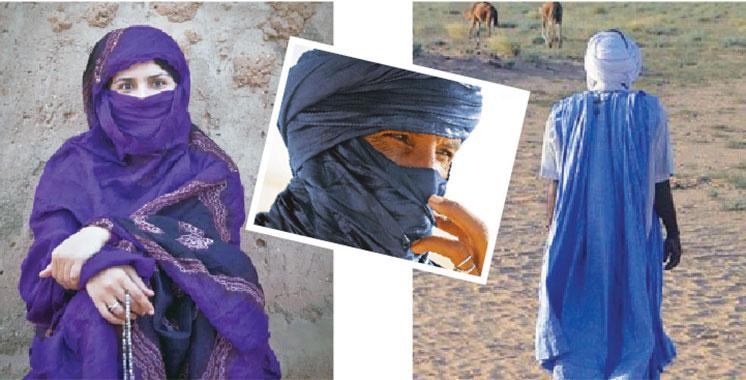Discovering the traditional clothes of the Sahrawis<
Clothing effects to which they are very attached
Sahrawis have no difficulty performing any task, however complex, wearing their traditional clothes. One would think that these clothes would present an embarrassment in the movements and displacements of the day, this is by no means the case. Sahrawis go about their activities as normally as possible
Men and women in the southern provinces have special clothes of various types and designs, the man wears the Darâa while the woman officially wears the Melhfa.
Traditional costumes in desert regions are comfortable and suitable for the desert, as they are designed to suit the hot and dry climate. Most of these garments are roomy and light and in summery, open colors that match the desert climate.
In general, the clothes of both sexes are characterized by modesty, decency, humility, dignity, good taste and simplicity. The Sahrawi finds no problem working while wearing his traditional clothes, which could reflect a contradiction between the dragging coat and the flexibility required for practical tasks.
“Sahrawis have no difficulty performing any task, no matter how complex, wearing their traditional clothes. One would think that these clothes would present an embarrassment in the movements and displacements of the day, this is by no means the case. Sahrawis go about their business as normally as possible,” explains Ali, a young trader in traditional clothes based in Dakhla. According to him, "the inhabitants of the southern provinces are very attached to their traditional costumes transmitted from one generation to another and which reflect the rich heritage of the nomads of the region".
These traditional clothes are among the most important cultural constituents of local society, a connotation of its distinctive cultural character, and at the same time a reflection of history, heritage and customs, and there is no doubt that the traditional dress and the culture of clothing are of particular importance in the society of the tribes of the Moroccan Sahara, because they affect feeling and passion. Indeed, Sahrawi clothing remains a characteristic of the family at the local level and is characterized by the simplicity of manufacture.

The design of traditional costume has been affected by religion, climate and civilization, for example women hold to the Melhfa because it matches the instructions of the religion and the customs and usages of the region, and achieves its goals of decency and modesty as a fundamental pillar of the Sahrawi Moroccan Bedouin community.
The Daraa
The Darâa is one of the popular costumes worn by men in the Sahara. It is a wide and open tunic on both sides. There is also a breach in the chest with a pocket called “Ellebna”. It comes in two colors: white or blue. In addition, there are the "kchat" pants attached to thin leather belts, and then the "Stembel" pants: baggy pants (baggy) of the same color as the Darâa wide on the side of the buttocks and tapering in the direction of the middle of the leg. Its price starts at 300 DH and can reach up to 3,000 DH.
Litham
Considering its varied uses and benefits, it is the most important piece of components of a Sahrawi man, who used to use it in several tasks. The litham is used by the Saharawi man to protect his head and face from the heat and can be used as a light sheet when sleeping in summer, or a towel after ablutions to wash his face or hands. It is also used as a bandage for wounds, as a rope to tie camels or to draw water with buckets from wells..., as a shopping basket, in addition to its added and aesthetic value accompanying the wearing of the Daraa.
The Melhfa
It is a garment four meters long and its width is not more than 160 centimeters worn by the Sahrawi woman, wherever she goes. But the Melhfas are not all the same, there are those dedicated to festivals and ceremonies and those that they wear every day. Similarly, a distinction must be made between the Melhfa worn by the old Sahrawi woman and that of a young woman. While the prices vary according to the quality of the fabric and are between 50 and 2,000 DH, depending on the choice made by the person concerned. Formerly, the Sahrawi girls had a dress similar to a Darâa, composed of two pieces of two different colors, blue and black, with only one "braid", but at the age of maturity, the young girl wore the Melhfa. However, the changes that the local society has experienced have affected the latter. Young girls are increasingly opting for colorful clothes instead of the black that dominated for several decades.


 Tags:
Tags: Prev
Prev







